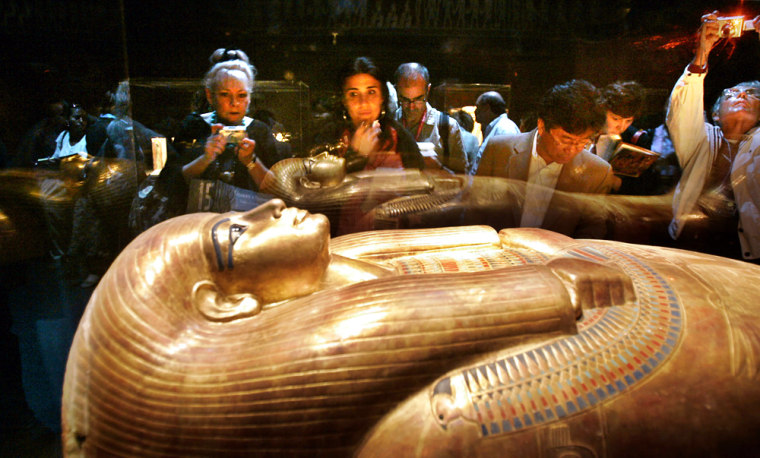The 3,300-year-old world of King Tut has returned to the United States in an exhibition that hopes to rival the 1970s tour of ancient Egyptian artifacts that became a cultural phenomenon.
"Tutankhamun and the Golden Age of the Pharaohs" opens to the public Thursday at the Los Angeles County Museum of Art, and advance ticket sales to see the Boy King's exhibit hit 250,000.
"This town loves youth," said Terry Garcia, executive vice president at the National Geographic Society, a co-sponsor of the exhibit. "It also loves a comeback. This is the greatest comeback tour in history."
It will have to be a blockbuster sequel to exceed the last U.S. exhibition of Tut artifacts. A sensational 1976-79 tour drew some 8 million people.
This time around, curators are banking on those who saw or just heard about the last show to bring newcomers to the sprawling exhibit of more than 130 artifacts from the tombs of Tut and his ancestors. Items from the first exhibition are nowhere in sight.
"If you're in Los Angeles, people still remember and talk about their first experience with the King Tut exhibition three decades ago," said Andrea Rich, president of the Los Angeles County Museum of Art. "We have no doubt the same will be true with this exhibition."
For national curator, David P. Silverman, context was key. The exhibition does not focus solely on King Tut, but provides a wide-angle view of the time preceding the boy's ascension to the throne and the religious realities of the world Tut inherited.
"It's not just important to show the objects in cases, you must put them into context," said Silverman, who also curated the previous Tut exhibit in Chicago.
Arranged chronologically into 11 galleries, visitors are first confronted with the simple humanity of King Tut, in the form of a wooden figure — head and torso — taken from his tomb. In the darkened room, all light rests on the Boy King depicted without the gold and jewels that have earned him his latest moniker — King of Bling.
First marking the discovery of Tut's tomb in 1922, the exhibition presents 50 items buried with the Boy King, including several pieces of furniture, a game board and two golden statuettes.
One gallery is dedicated solely to items found with Tut's mummified remains, including a ceremonial dagger on his left thigh and a gold crown found around his head.
But perhaps the most prized object is the coffinette that contained Tut's mummified liver. The ornate figurine is propped open, and a peek inside shows rows of intricate hieroglyphs set in gold.
The gallery ends with a video showing digital scans of Tut's remains, part of a five-year project partially funded by National Geographic. The scans show he was not killed by a crushing head blow, as had been theorized, but perhaps died from a broken left leg and subsequent gangrene infection.
Sponsors expect some 1.2 million people will see the Los Angeles exhibition, which runs through Nov. 15, before the show travels to Fort Lauderdale, Fla., Chicago and Philadelphia. A schedule of dates can be found at the exhibit's Web site, http://www.kingtut.org/.
Tickets cost $25 apiece for weekdays and $30 for weekends.
An estimated $35 million of the exhibition's proceeds will be used for conservation efforts in Egypt. The country has announced plans to build 13 new museums.
"Egypt is proud to share these treasures with another generation," said Ahmed El-Maghraby, Egypt's tourism minister. "Tourism is another bridge to peace and understanding."
